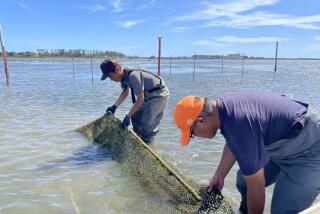Prediction for Future: A Shrimp in Every Pot
- Share via
Record production of farmed shrimp is deflating the premium price of this delicacy, according to an authoritative recent report on aquaculture.
What makes this particularly unusual is that the decline in price, as much as 10% for medium-sized shellfish, is taking place during the holiday season when consumer seafood purchases are strongest.
Forty countries now cultivate shrimp in ponds, tanks or enclosed bays. It’s a multibillion dollar industry, according to “World Shrimp Farming 1990” (published by San Diego-based Aquaculture Digest). And its wide availability is transforming shrimp from a luxury food into a mainstream commodity.
According to the report, the farms, which are concentrated primarily in Asia, now account for 25% of the world’s harvest; up from only 2% in 1980. More than 633,000 metric tons of cultivated shrimp are grown every year, the bulk of which is sold in Japan and the United States.
But while the proliferation of shrimp farming has been a huge success for aquaculture technology, it is now in serious danger of outpacing consumer demand.
“In the last year or so, production is increasing faster than consumption,” says Bob Rosenberry, Aquaculture Digest publisher. “Everyone thinks you can make a fortune . . . but it’s a very tough industry . . . especially now with falling prices.”
He points out that a local supermarket chain was selling raw, medium-sized shrimp (between 41 and 50 shrimp per pound) for $3.99 a pound last week.
The National Fisheries Institute, a trade group, says that Americans consumed more than 567 million pounds of shrimp--wild and farmed--last year. According to industry data, shrimp is second only to tuna in terms of per-capita consumption of seafood in the U.S. and leads all other species in revenue generated.
So it’s no surprise that shrimp are at the center of an industry effort to increase seafood consumption by the year 2000 to 20 pounds per capita from its current level of 15.9 pounds.
“Shrimp is the (seafood) category most likely to fill the greatest share of the increase in consumption based on projected product availability,” a fisheries institute report stated, noting that the anticipated increase will come exclusively from aquaculture ventures.
Rosenberry estimates that the current supply-demand imbalance, along with an uncertain economy, will create more dramatic price declines in the months to come.
“What would happen to shrimp prices during a prolonged recession? They would drop like a rock,” Rosenberry writes. “Most shrimp is purchased in restaurants and in grocery stores for special occasions. During recessions, consumers cut back on meals away from home. (And) they skip high-priced luxury items like shrimp.”
An even gloomier picture is painted by a recent World Bank report, Rosenberry notes. Within 24 months, wholesale shrimp prices may fall as much as 30% below 1988 levels if current increases in production are maintained.
But while farmed shrimp experienced impressive growth in 1990, industry observers note that the wild harvest remains static, if not reduced.
“The catch from Mexico and the West Coast is down (in the past year),” says Peter Redmayne, editor and publisher of Seafood Leader, a Seattle-based trade magazine. “So, wild shrimp supplies are probably down overall but their prices remain stable because of the increased competition from the farmed product.”
Redmayne says that there may be further dramatic changes in prices next month when the People’s Republic of China, the world’s leader in farmed shrimp, begins releasing its annual harvest.
“The big wild card is that no one knows what’s going on in China,” he says. “The harvest is supposed to go through the central government but there is always confusion about how much they have. . . . Their marketing system is chaotic. . . . If they flood the market with a lot of shrimp after the first of the year then prices are definitely down; maybe another 15% to 20%.”
The long-range outlook is also for lower prices. Rosenberry predicts that farmed varieties will constitute 50% of all shrimp sold by the turn of the century.
“Shrimp prices will stabilize at lower levels and the world’s consumers will have a new, moderately priced alternative to fish, red meats and chicken,” he states.






